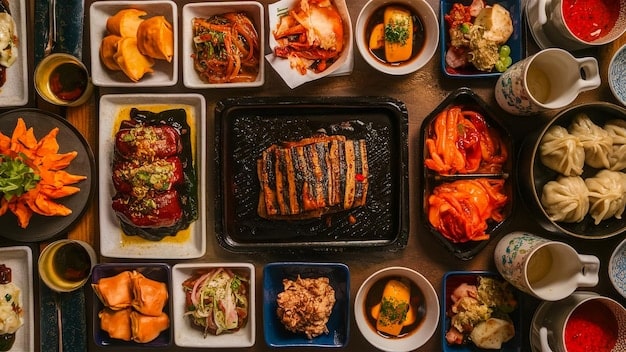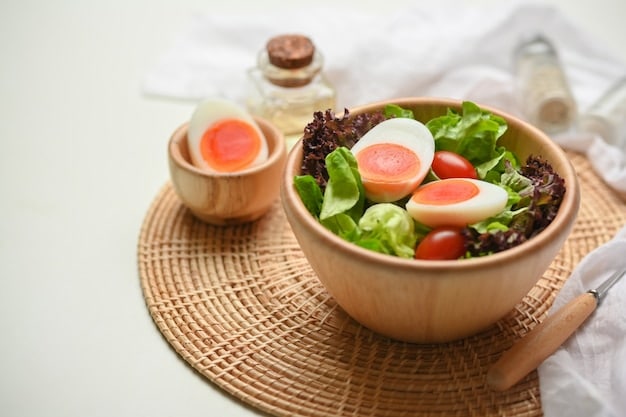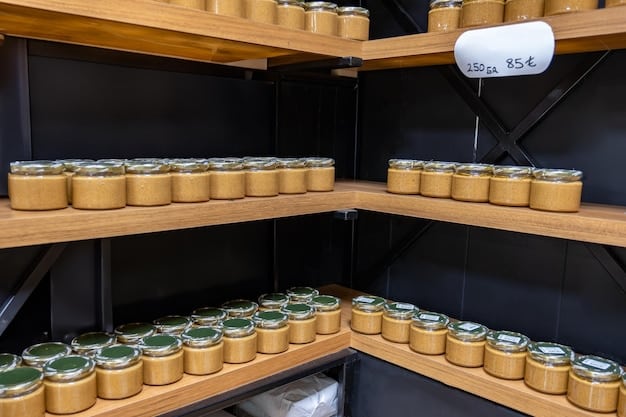K-Drama Food Trends: US Ingredient Swaps for Authentic Dishes

K-Dramas have popularized many Korean dishes, inspiring viewers to recreate them at home; this article provides ingredient swaps readily available in the US to achieve authentic flavors.
Have you ever watched a K-Drama and suddenly craved the delicious food the characters are enjoying? You’re not alone! K-Dramas have a unique way of showcasing Korean cuisine, making viewers eager to try these dishes themselves. The good news is, you don’t need to travel to Korea to enjoy authentic Korean flavors. With a few clever ingredient swaps using items readily available in the US, you can recreate your favorite K-Drama meals right in your own kitchen. Let’s explore some popular K-Drama Food Trends: Recreate Authentic Korean Dishes at Home with These US Ingredient Swaps.
Exploring Popular K-Drama Inspired Dishes
K-Dramas offer a delightful window into Korean culture, and food plays a starring role in many of these shows. From heartwarming family meals to late-night street food adventures, the dishes featured often become as iconic as the characters themselves. Let’s dive into some of the most beloved K-Drama dishes and how you can bring them to your table.
Kimchi Jjigae (Kimchi Stew)
Kimchi Jjigae is a staple in Korean households and frequently appears in K-Dramas. This spicy and savory stew is made with aged kimchi, tofu, pork (or other protein), and gochujang (Korean chili paste). It’s a comforting and flavorful dish that’s perfect for a cold day.
Tteokbokki (Spicy Rice Cakes)
Tteokbokki is a popular Korean street food that has gained international fame thanks to K-Dramas. These chewy rice cakes are stir-fried in a sweet and spicy gochujang-based sauce, often with fish cakes, scallions, and boiled eggs. It’s a quick, satisfying, and addictive snack.

Here are some other dishes you might see in K-Dramas:
- Bibimbap (Mixed Rice): A colorful and balanced dish with rice topped with seasoned vegetables, meat, a fried egg, and gochujang.
- Ramyeon (Korean Ramen): Instant noodles elevated with various toppings like eggs, vegetables, and kimchi.
- Korean Fried Chicken: Crispy and flavorful fried chicken with a variety of sauces, often enjoyed as a late-night snack.
- Japchae (Glass Noodles): Stir-fried glass noodles with vegetables and meat in a savory soy sauce-based sauce.
These dishes are just a small sample of the incredible culinary experiences that K-Dramas offer. By exploring these dishes, you can get a taste of Korean culture and create delicious meals at home.
Essential Korean Ingredients and US Swaps
Creating authentic Korean dishes sometimes requires ingredients that might not be readily available at your local grocery store. However, with a few smart substitutions, you can still achieve the desired flavors without compromising the essence of the dish. Here’s a guide to some essential Korean ingredients and their US-friendly swaps.
Gochujang (Korean Chili Paste)
Gochujang is a fermented chili paste that is a cornerstone of Korean cuisine. It’s spicy, savory, and slightly sweet, adding depth and complexity to dishes. While it’s becoming more widely available in the US, you can substitute it with a mix of:
- Miso paste (for umami)
- Sriracha (for heat)
- A touch of maple syrup or honey (for sweetness)
Gochugaru (Korean Chili Flakes)
Gochugaru is another essential chili product, used for its vibrant color and moderate heat. It’s crucial for kimchi and many other dishes. If you can’t find gochugaru, you can use:
- A mix of paprika (for color)
- Red pepper flakes (for heat), adjusting to your spice preference
Doenjang (Korean Soybean Paste)
Doenjang is a fermented soybean paste similar to miso, but with a more robust and pungent flavor. It’s used in stews, soups, and as a dipping sauce. As an alternative, you can use:
- Japanese miso paste (preferably a darker variety)
- Adding a small amount of soy sauce for extra depth
Sesame Oil
Sesame oil is used generously in Korean cooking, adding a nutty and aromatic flavor to dishes. While there isn’t a direct substitute for sesame oil, ensure you’re using high-quality sesame oil for the best results. Look for toasted sesame oil for a more intense flavor. Most mainstream grocery stores carry this, but be sure to read the label and check for quality.
These ingredient swaps will help you create delicious Korean dishes at home, even if you don’t have access to all the traditional ingredients. Experiment and adjust the ratios to suit your taste preferences.
Finding Korean Ingredients in the US
While ingredient swaps can be handy, sourcing authentic Korean ingredients directly can significantly enhance your cooking experience. Fortunately, the growing popularity of Korean cuisine has made these ingredients more accessible in the US. Let’s explore some of the best places to find Korean ingredients.
Korean Grocery Stores
Korean grocery stores, such as H Mart and Galleria Market, are treasure troves of Korean ingredients. They offer a wide variety of kimchi, gochujang, gochugaru, doenjang, and other essential items. These stores often have fresh produce, meat, and seafood specifically catering to Korean cuisine.
Asian Grocery Stores
Asian grocery stores, in general, are a great resource for Korean ingredients. They typically carry a selection of Korean sauces, noodles, and dried goods. Look for sections dedicated to Korean products or ask store employees for assistance.

Online Retailers
Online retailers like Amazon and specialized Korean food websites offer a convenient way to purchase Korean ingredients. You can find a vast selection of products, including hard-to-find items, delivered directly to your door. Reading product reviews can help you choose the best brands and quality.
Here’s a list of popular Korean ingredients you should keep an eye for:
- Kimchi (Fermented Cabbage): A staple in Korean cuisine, available in various levels of spiciness and fermentation.
- Gochujang (Korean Chili Paste): Used for adding a spicy and savory flavor to dishes.
- Gochugaru (Korean Chili Flakes): Essential for making kimchi and adding heat and color to various dishes.
- Doenjang (Korean Soybean Paste): Adds a rich and savory flavor to stews and soups.
By exploring these resources, you’ll have no trouble finding the Korean ingredients you need to recreate your favorite K-Drama dishes at home.
Adapting Recipes and Cooking Techniques
Once you have your ingredients, the next step is to adapt recipes and master some basic Korean cooking techniques. While there are countless Korean recipes available, it’s helpful to understand the fundamental principles that underpin Korean cuisine. This information can assist you with using K-Drama Food Trends: Recreate Authentic Korean Dishes at Home with These US Ingredient Swaps.
Balancing Flavors
Korean cuisine emphasizes a balance of flavors – sweet, sour, spicy, salty, and bitter. Many dishes incorporate multiple flavor profiles to create a harmonious and complex taste. Experiment with different combinations of ingredients to achieve this balance.
Marinating Meats
Marinating meats is a common technique in Korean cooking. Marinades typically include soy sauce, garlic, ginger, sesame oil, and sugar. Marinating not only adds flavor but also tenderizes the meat.
Fermentation
Fermented foods, such as kimchi and doenjang, play a significant role in Korean cuisine. Fermentation adds depth and complexity to flavors, as well as providing beneficial probiotics.
Here are some points to consider when adapting recipes from K-Dramas:
- Adjust Spice Levels: Many Korean dishes are spicy, but you can adjust the amount of gochujang or gochugaru to suit your spice tolerance.
- Adapt Portion Sizes: Korean cuisine is often served family-style, with multiple side dishes. Adjust portion sizes to suit your needs.
- Substitute Ingredients Creatively: Don’t be afraid to experiment with ingredient swaps based on what’s available to you.
By understanding these basic principles and techniques, you can confidently adapt recipes and create authentic Korean dishes that capture the essence of your favorite K-Dramas.
Creating a K-Drama Inspired Meal at Home
Now that you have the knowledge and ingredients, it’s time to create a K-Drama inspired meal at home. Start by choosing a K-Drama that features a lot of food scenes, and then select a few dishes that pique your interest. Remember, the experience is just as important as the food itself.
Setting the Mood
Create a cozy and inviting atmosphere by setting the table with Korean-style tableware, such as ceramic bowls and metal chopsticks. Play some K-Drama OSTs (Original Soundtracks) in the background to complete the ambiance.
Choosing Your Dishes
Select a variety of dishes that offer a balance of flavors and textures. Consider including a main dish, a soup or stew, and several side dishes (banchan). Kimchi is a must-have!
Banchan (Korean Side Dishes)
Banchan are an integral part of a Korean meal. These small side dishes offer a variety of flavors and textures, complementing the main dish. Common banchan include:
- Kimchi
- Namul (seasoned vegetables)
- Braised tofu
- Pickled radish
Sharing the Experience
Korean meals are often shared family-style, with everyone gathering around a table to enjoy the food together. Invite friends or family to join you for a K-Drama inspired feast.
To pull it all together, use these tips:
- Plan Ahead: Prepare ingredients and sauces in advance to streamline the cooking process.
- Embrace Imperfection: Don’t worry if your dishes don’t look exactly like those in the K-Drama. The most important thing is to enjoy the process and the flavors.
- Have Fun!: Cooking and eating Korean food should be a fun and enjoyable experience.
By following these tips, you can create a memorable K-Drama inspired meal that will transport you to the world of your favorite shows.
Health Benefits of Korean Cuisine
Beyond the delicious flavors and cultural appeal, Korean cuisine offers numerous health benefits. Many Korean dishes are packed with nutrients, antioxidants, and probiotics, contributing to overall well-being. The inclusion of vegetables are especially important.
Nutrient-Rich Ingredients
Korean cuisine emphasizes fresh, whole ingredients, such as vegetables, lean proteins, and fermented foods. These ingredients provide essential vitamins, minerals, and fiber.
Fermented Foods
Fermented foods like kimchi, doenjang, and gochujang are rich in probiotics, which support gut health. A healthy gut microbiome can improve digestion, boost immunity, and even affect mental health.
Low in Processed Foods
Traditional Korean cuisine is relatively low in processed foods, refined sugars, and unhealthy fats. This makes it a healthier alternative to many Western diets.
Here is a summary of some of the health aspects of the most popular Korean dishes:
- Kimchi: Rich in probiotics, vitamins, and antioxidants.
- Bibimbap: A balanced meal with a variety of vegetables, protein, and healthy fats.
- Korean Soups and Stews: Often made with nutrient-rich ingredients like vegetables, tofu, and seafood.
Incorporating Korean dishes into your diet can have a positive impact on your health. However, it’s important to be mindful of portion sizes and sodium content, as some Korean dishes can be high in sodium.
In conclusion, Korean cuisine is not only delicious and culturally rich but also offers numerous health benefits. By enjoying a variety of Korean dishes, you can nourish your body and soul.
| Key Point | Brief Description |
|---|---|
| 🍚 Authentic Flavors | Achieve Korean tastes with US ingredient swaps. |
| 🌶️ Spice Level | Adjust spice to suit your preference with gochujang/gochugaru. |
| 🛒 Ingredient Sourcing | Find Korean ingredients at Korean/Asian groceries or online. |
| 🥢 Meal Experience | Enjoy by creating a K-Drama-inspired atmosphere. |
Frequently Asked Questions (FAQ)
▼
Gochujang (Korean chili paste) is arguably the most important. It provides a unique blend of spicy, savory, and sweet flavor that is used in many Korean dishes.
▼
Yes, many Korean dishes can be made vegetarian. Bibimbap, Japchae, and various vegetable-based side dishes are popular options. Tofu can be used as a protein substitute.
▼
Kimchi can be made by fermenting napa cabbage with gochugaru, garlic, ginger, and other seasonings. Many recipes are readily available online, guiding you through the process.
▼
Korean sauces and pastes, like gochujang and doenjang, should be stored in the refrigerator after opening. They have a long shelf life due to their fermentation process.
▼
Yes, you can easily adjust the spiciness by controlling the amount of gochujang or gochugaru you use. Start with a small amount and add more to taste.
Conclusion
Bringing the vibrant flavors of K-Dramas into your kitchen is easier than you think. By utilizing US ingredient swaps, exploring Korean grocery stores, and mastering basic cooking techniques, you can recreate your favorite dishes from the screen and immerse yourself in the world of Korean cuisine. So, grab your chopsticks and get ready to embark on a delicious culinary adventure!






